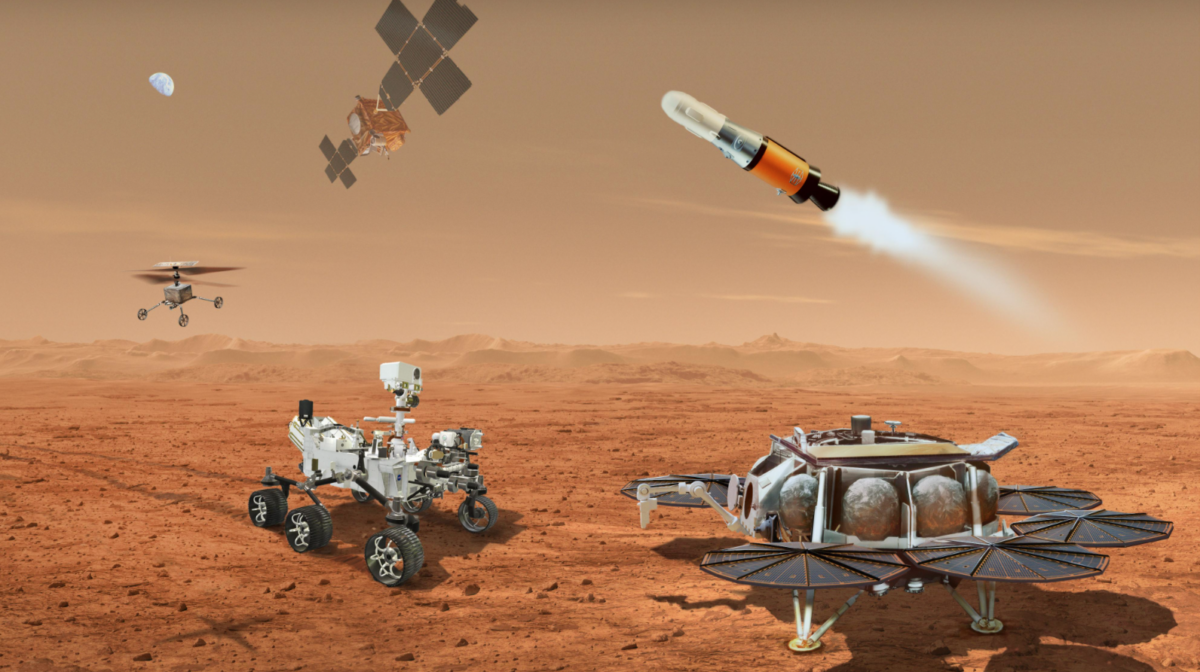NASA seeks help with JPL’s Mars Sample Return mission

Mars Sample Return Concept Illustration This illustration shows a concept for multiple robots that would team up to ferry to Earth samples of rocks and soil being collected from the Martian surface by NASA’s Mars Perseverance rover. Image: NASA/ESA/JPL-Caltech
PASADENA – Hoping to breathe new life into a long-planned but financially struggling effort to retrieve soil and rock samples from Mars and return them to Earth, NASA leaders are reaching out to the space-exploration community Monday for proposals that will lower the $11 billion cost and make the project happen far sooner than currently anticipated.
The Mars Perseverance rover, which is managed by Jet Propulsion Laboratory in Pasadena, has already collected surface samples on Mars and deposited them in specialized canisters for eventual pickup and return by future missions. It’s one of NASA’s most ambitious projects, requiring another space vehicle to land on Mars and collect the samples. The project would then require the first-ever rocket launch from another planet to blast the samples into orbit, where they can be gathered by yet another spacecraft and returned to Earth.
With NASA facing an overall funding crunch, the ambitious mission has been hit with budget cuts — contributing earlier this year to the layoffs of more than 500 people at JPL as the project was crippled.
“Mars Sample Return will be one of the most complex missions NASA has ever undertaken,” Nelson said. “The bottom line is, an $11 billion budget is too expensive, and a 2040 return date is too far away. Safely landing and collecting the samples, launching a rocket with the samples off another planet — which has never been done before — and safely transporting the samples more than 33 million miles back to Earth is no small task. We need to look outside the box to find a way ahead that is both affordable and returns samples in a reasonable timeframe.”
Nelson said the agency is reaching out to the “NASA community” to come up with a revised plan for carrying out the mission, relying on “innovation and proven technology.” The agency also plans to solicit proposals from the space industry for a streamlined process that would see the samples returned to early in the 2030s, and at a significantly lower cost.
Last month, roughly two dozen California congressional representatives sent a letter to Nelson calling on him to commit more funding to the JPL-led sample-return mission, calling it critical for space exploration and the restoration of jobs.
Rep. Judy Chu, D-Pasadena, was one of those who signed that letter. On Monday, she said she continues to push for commitment to the mission, but said she is “disappointed that after eight long months of review … NASA is only just now issuing a call for studies on the best path forward.”
“Furthermore, I am extremely concerned that NASA is proposing a funding level for MSR that will be insufficient for JPL to continue making robust progress on the mission without sacrificing its integrity,” Chu said in a statement. “It frustrates me that NASA has chosen the Planetary Science Decadal Survey’s highest-priority mission to absorb almost the entire share of funding reductions.
“So while I am disappointed with NASA’s announcements today, I remain dedicated to working with my colleagues to ensure increased funding is realized for this mission in Fiscal Years 2024 and 2025 so that the JPL workforce is protected and the mission is proceeding at pace while NASA and JPL evaluate solutions that could help us accomplish this exciting effort.”
Officials in China are planning a similar mission, saying recently that it hopes to launch the mission in 2030, with the samples arriving back on Earth by 2031.
Nicky Fox, associate administrator of the Science Mission Directorate at NASA Headquarters in Washington, said returning Mars samples to Earth for extensive study “is a key priority.”
“To organize a mission at this level of complexity, we employ decades of lessons on how to run a large mission, including incorporating the input we get from conducting independent reviews,” Fox said in a statement. “Our next steps will position us to bring this transformational mission forward and deliver revolutionary science from Mars — providing critical new insights into the origins and evolution of Mars, our solar system, and life on Earth.” (CNS)

